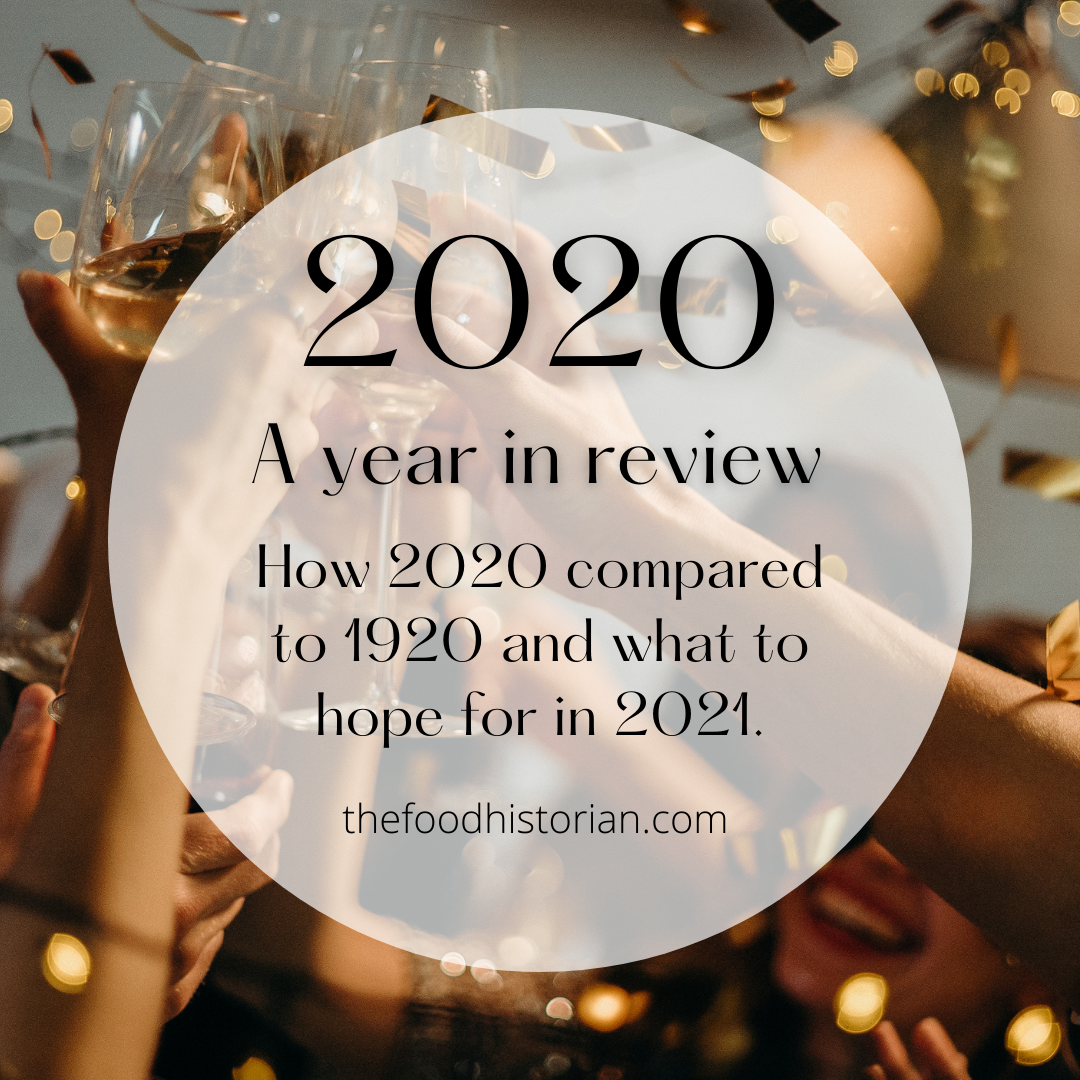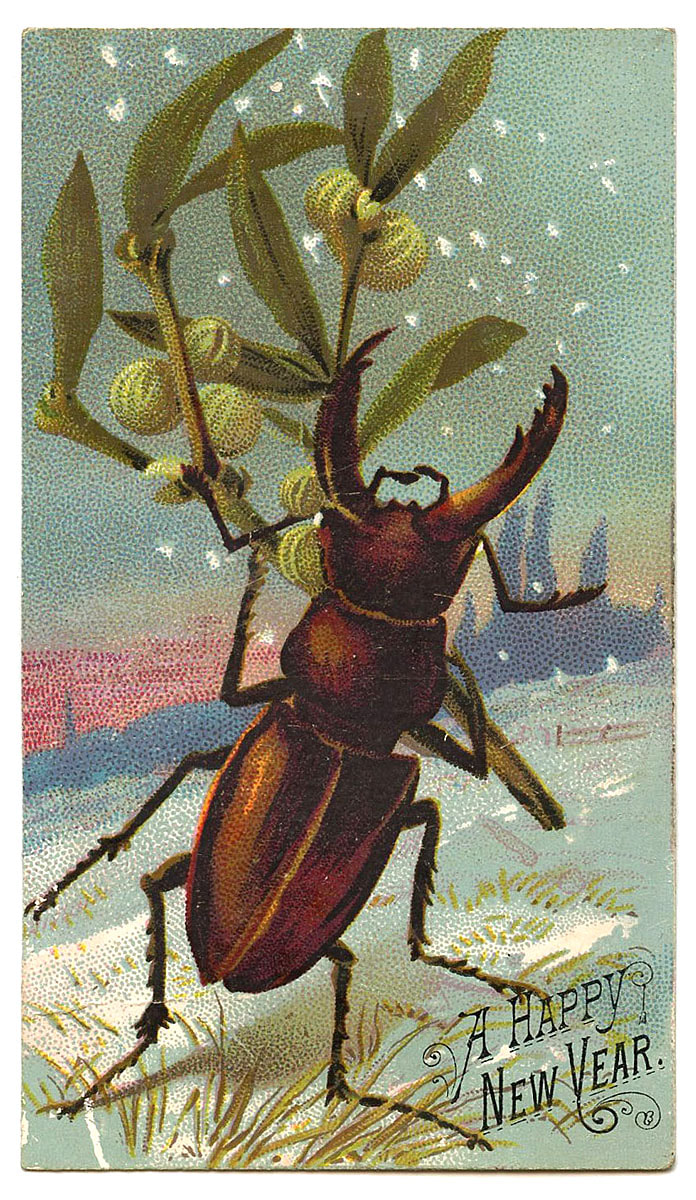|
On New Year's Eve with broke with tradition a little and did a surprise THURSDAY Food History Happy Hour at 11 PM. Because it was spur of the moment, we didn't really have a specific topic, but we did talk about comparisons between 1920 and 2020, an update about my office/cookbook library, my family New Year's Eve traditions old and new, some of the "lucky" foods of NYE, the Swedish celebrations I grew up with, including Tjuegondag Knut and Sankta Luciasdag, 19th century New Year's menus, what I missed most in 2020, and hopes for 2021.
Vanilla Fig Bourbon Recipe
No historic recipe this time, but the fig bourbon turned out quite nicely! If you want to make your own, here's a nice recipe:
2 cups dried mission figs 1 vanilla bean bourbon to fill a quart jar Put the figs in a quart mason jar. Cut the vanilla bean in half and add to the jar. Fill with enough bourbon to cover the fruit. Let age 3-12 months before consuming. I had some on the rocks with ginger ale. And some of the figs may make their way into a boozy fruitcake at some point. Episode Links
Not too many this time around, but here are a few to whet your whistle:
The next Food History Happy Hour will be on Friday, January 15, 2021 at 8:00 PM EST. We're gonna discuss more in-depth January holidays, including revisiting New Year's, Twelfth Night, Tjuegondag Knut, and my birthday, with a discussion of birthday cake history! See you next time.
The Food Historian blog is supported by patrons on Patreon! Join us for awesome members-only content like free digitized cookbooks from my personal collection, e-newsletter, and even snail mail from time to time!
0 Comments
What a year this has been. A global pandemic, flailing economy, the end of truth as we know it, and the abject failure of political leadership in our country (to the point of cult-like devotion to a would-be dictator) - I don't think anyone thought 2020 would turn out like it did. But, surprisingly, it has a lot more parallels to 1920 than we might think. I've already written about comparisons between the coronavirus pandemic and WWI and the Spanish Flu, including eerie parallels with struggling onion farmers (similar things happened with milk and dairy farmers, but I didn't manage to get a blog post up about that!), and as 1920 was the start of Prohibition, I wrote about the Temperance movement and our road to Prohibition. Other parallels to 1920 include a widening income inequality, including struggles with stagflation (a.k.a. the "high cost of living"), the politics of laissez faire economics that favored big business over ordinary people, a post-war recession as European agriculture and manufacturing rebounded, racial tensions and violence and the rise of the KKK (including the work of the Daughters of the Confederacy to rewrite textbooks and put up Confederate monuments). All of these as-of-yet unaddressed issues that are all rising up again, 100 years later. When the year first started, I was looking forward to our own "Roaring Twenties" decade, but what I had in mind was more jazz, loosening social strictures, and feminism. Not global pandemic, economic and racial strife, and crazy politics. My 2020 New Year's Resolutions didn't turn out quite as I'd hoped. My goals were to write more, teach, organize, and form a food historian community. I didn't get as much writing done on Preserve or Perish as I wanted. I underestimated how much a global pandemic would hamstring the intense higher thought that is required for the complicated task of original research and book editing. I DID make progress though, and that's what counts. What I did to was write a lot more about cookbooks and historic recipes, which WAS one of my goals, as I look back. Although I did not get any online courses up (although at least two are percolating as we speak), I DID do a lot of virtual teaching, both informally through Food History Happy Hour, which was often the highlight of my week or month, and more formally with the incredible number of virtual speaking engagements I did this year (and already 2021 looks like it might outstrip 2020, now that people are used to Zooming). The organizing I didn't get much of a chance to do until this month! Some Christmas money meant I could afford to order 3 more bookshelves to match my existing ones in my guest-bedroom-cum-office-and-library, and that's about it in terms of what I can fit up here. I also rearranged where my desk is and made room for the new shelves, which should arrive next week. And while I didn't go about creating an intentional food historian community, I have watched with pleasure the new folks joining in on Facebook, the food history community on Instagram, and of course everyone who has supported me on Patreon. My goals in 2021 are a little more modest - keep Food History Happy Hour going as long as I can, keep plugging away on the book, and keep this blog going. And finish reorganizing my library and making my office more functional and cozy. I didn't expect to spend nearly as much time up here as I did, but working from home does that to a girl. Do you have any 2021 goals? Or don't want to jinx it? Top 10 Posts of 2020My maintenance of the blog was a little more hit or miss this year than I would have liked. Sadly, World War Wednesday kind of fell by the wayside compared to 2019, although I hope to bring it back in full force in 2021. I did, however, get to focus a lot more on historic recipes. Here are the top 10 blog posts (thanks, Google Analytics!), published in 2020, in order of popularity. 1. Black Food Historians You Should Know This one I published back in February of this year, but I wrote it because with a few exceptions, I felt that Black food historians were not getting their due in the food sphere. 2. Food History Happy Hour: Beef Fizz (1960s?) This is the only Food History Happy Hour post on the list, which is kind of sad considering how many of them I did! But no one could deny the lure of the beef fizz craze that made the rounds of the internet, thanks to a Reddit post. I still haven't tracked down where the original recipe came from, so if anyone has an idea, let me know! 3. Food and the "Flu": Spanish Flu of 1918 The coronavirus pandemic was on everyone's mind earlier this spring, and since comparisons abounded to the Spanish Influenza epidemic of 1918 (which lasted well into 1919), I thought I would see what I could dig up on the food history of the "flu." 4. The Real Story Behind the "Gross" Black and Orange Halloween Taffy Moral of the story here is apparently I need to hop on more random internet trends. This one was inspired by another meme making the rounds of social media and it was fun to dig into the real history. 5. Lydia Maria Child's Pumpkin Pie (1832) The timeliness of this post, which I put up the day before Thanksgiving, probably had a lot to do with its popularity, but it was also my first cooking demo video! So that was also fun. 6. World War Wednesdays: Gospel of the Clean Plate This short and sweet blog was one of the first of the year - discussing the issue of food waste and food conservation during WWI. Why it got so popular I have no idea, but there you go! 7. Celebrating Indigenous Foods Another one I managed to publish "on time" for Native American Heritage Month, it also came at a time of reckoning with American mythology around the pending Thanksgiving season. It was fun to research - there were a few foods on the list that even I didn't realize were indigenous to the Americas. 8. One Year Later - The Food That Built America I have to tell you - I STILL get people, old friends, acquaintances, and even occasionally strangers, who excitedly tell me - I saw you on TV!!! :D I'm just glad the show turned out so nicely and (spoiler alert) keep your eyes peeled for yours truly on at least one, possibly two more shows in 2021. 9. Scratch Chicken & Dumpling Soup (1942) The colder weather and the still-raging pandemic must have meant that folks wanted to stay in and be cozy. And this dumpling recipe from Ida Bailey Allen hit the spot. 10. Virginia Apple Pecan Election Cake Another timely one, this time posted ON election day. Although it's not a "real" election cake in terms of historical association with election day, it was still delicious and much easier than the yeast-based real deal. And that, my dears, is that. Did you have a favorite blog post from 2020? If you missed the earlier ones, you can always peruse the month-by-month listings on the blog (at right) or by category. You can also use the search box at the bottom of every page of the website. Here's to seeing 2020 quickly out the door, and hopefully welcoming in a kinder, more sane, more truthful 2021. The Food Historian blog is supported by patrons on Patreon! Join us for awesome members-only content like free digitized cookbooks from my personal collection, e-newsletter, and even snail mail from time to time! |
AuthorSarah Wassberg Johnson has an MA in Public History from the University at Albany and studies early 20th century food history. Archives
July 2024
Categories
All
|




 RSS Feed
RSS Feed